
In his response in early September, David Taormino, the developer of the West Davis Active Adult Community (WDAAC), noted the use of “half-truths, distortions, exaggerations and even falsehoods” in a number of the pieces by the opposition.
For instance, “Their first article contained 23 misleading, distorted and exaggerated statements…” Later, he said that there were so “many misstatements, distortions, fabrications and nit picking in the second article” that he would not “waste the reader’s time by responding to each.”
Altogether, Mr. Taormino wrote, “their articles contain at least 50 distortions all protected by the United States Constitution.”
However, the Vanguard believes that if the developer is going to claim that there are a large number of falsehoods, he should elaborate on them. The Vanguard sat down with Mr. Taormino and his  development team on Friday.
development team on Friday.
Mr. Taormino took the time to highlight, color code, and label the 97 alleged distortions.
He created five categories where he listed each of the statements – though some of them were repetitive and the claims were repeated – and put their corresponding number under the category.
The first category is “distortion” which Mr. Taormino defines as: “The action of giving a misleading account or impression.” He identifies, in his view, 18 such statements.
The second category is “falsehood,” that these are simply “untrue” statements. He identifies 44 such statements.
The third category is “exaggeration” or “a statement that represents something as better or worse than it really is.” There are 12 such statements identified by Mr. Taormino.
The fourth category is “half-truth” – “a statement that mingles truth and falsehood with deliberate intent to deceive.” There are 10 identified statements.
Finally there are “opinions,” which naturally are “a view or judgement formed about something, not necessarily based on fact or knowledge.” He identifies 9 such statements.
The intention of the development team will be to submit a piece that elaborates on some of their views of the statements.
Here, they present all of the text of the opposition pieces reviewed with highlights and labels included.

Labeled articles:



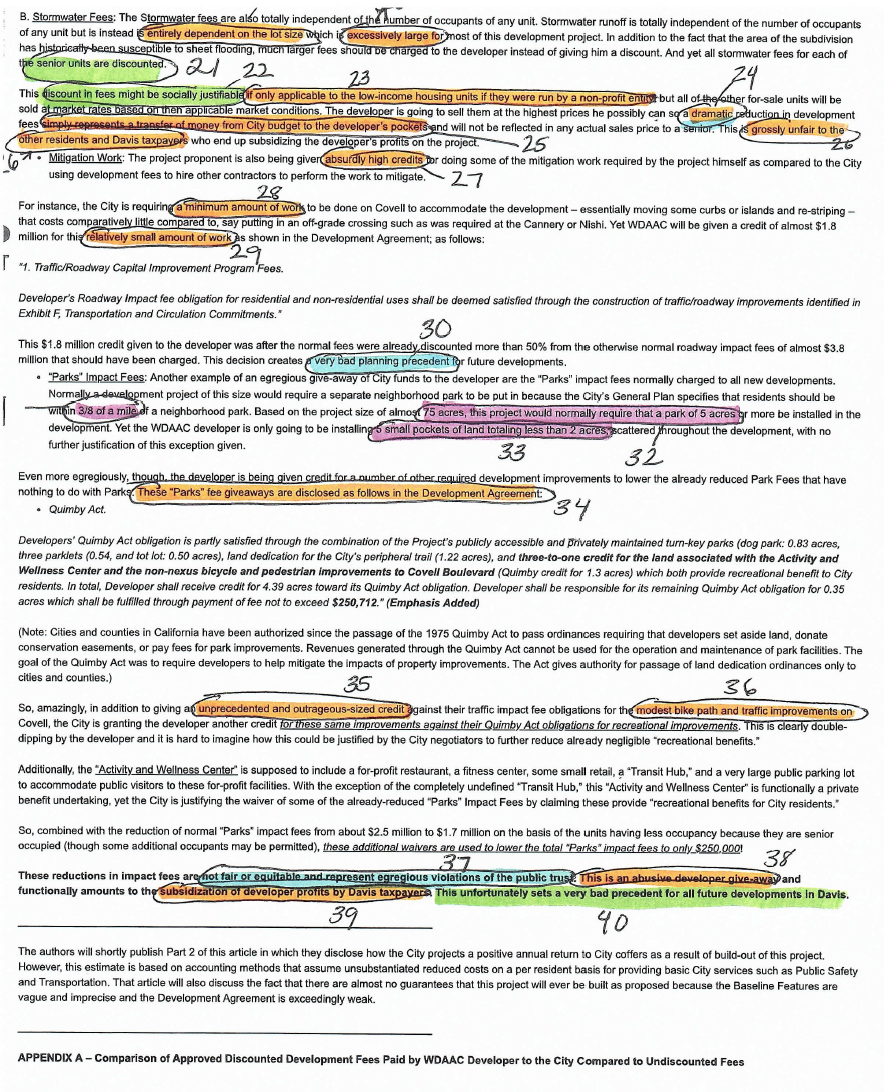
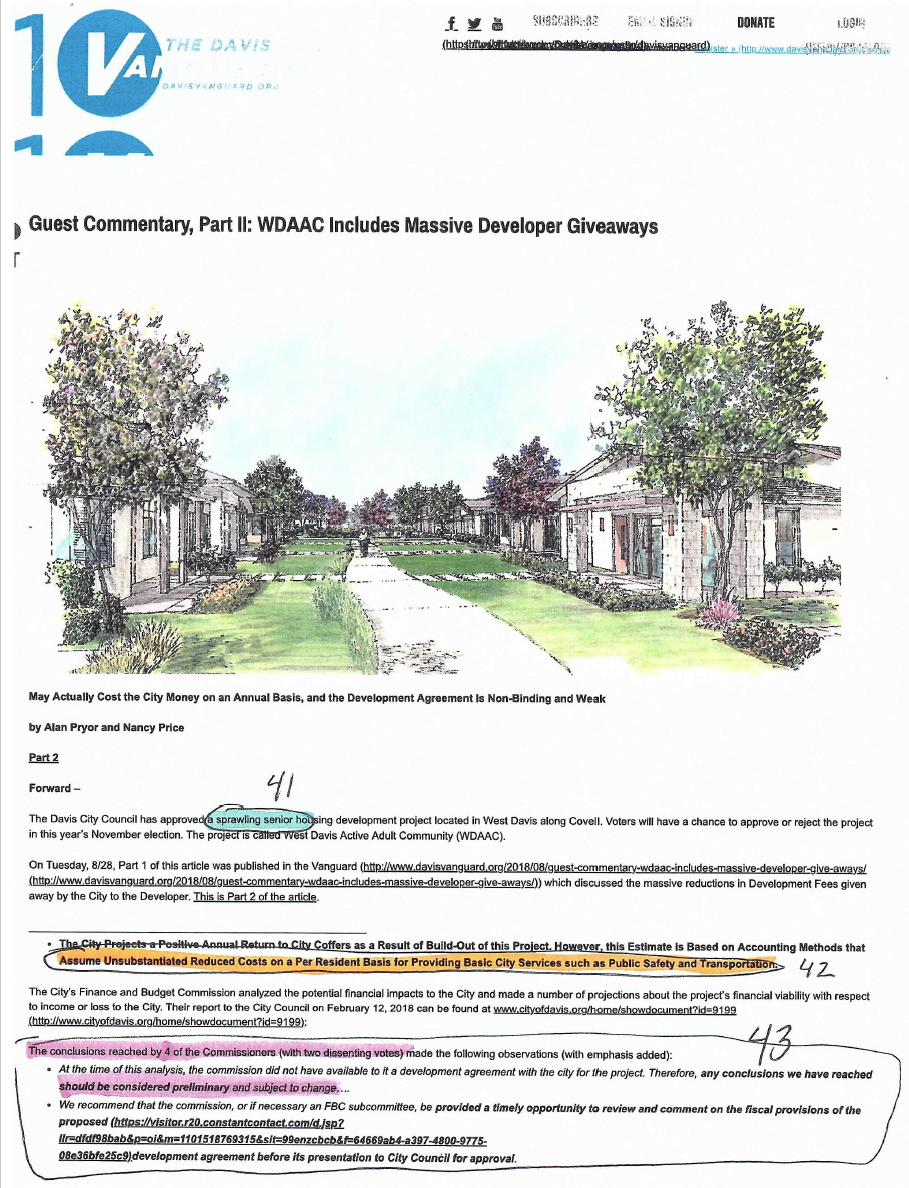
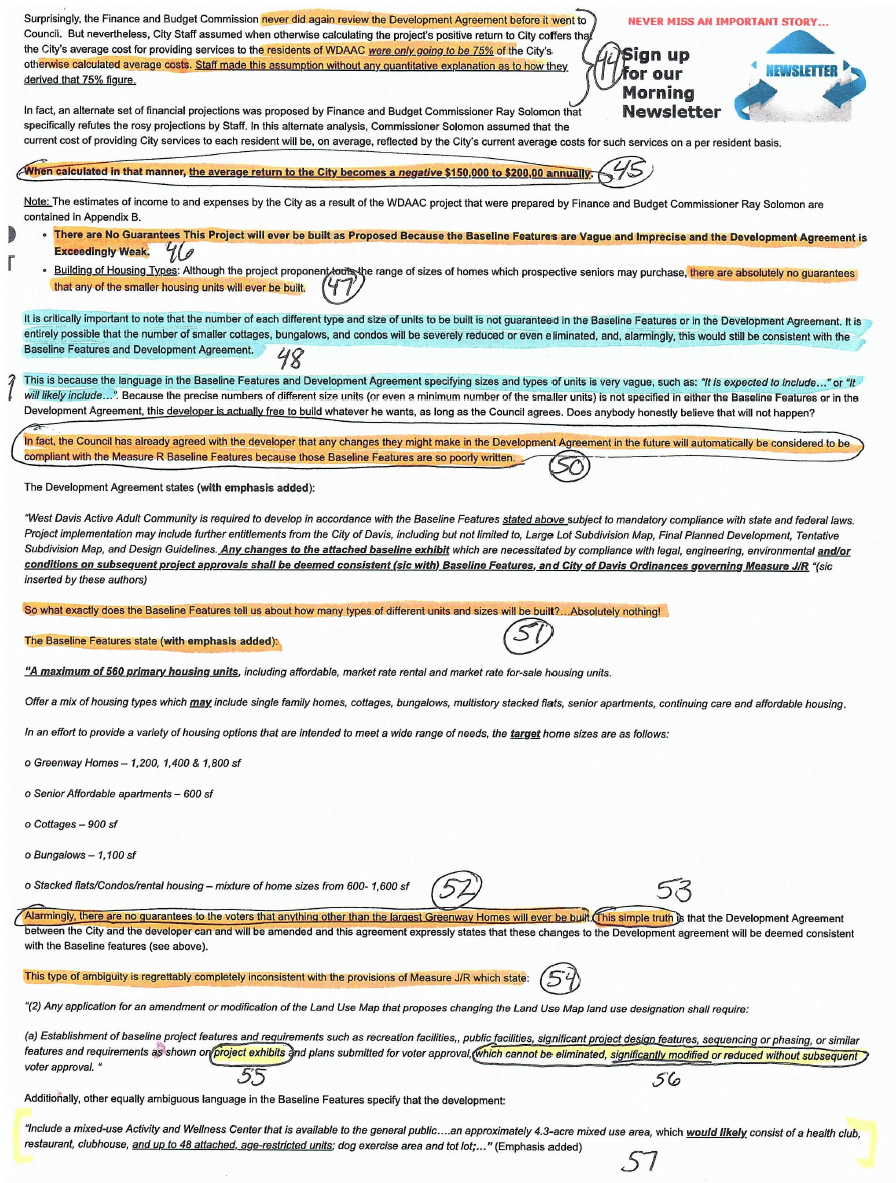
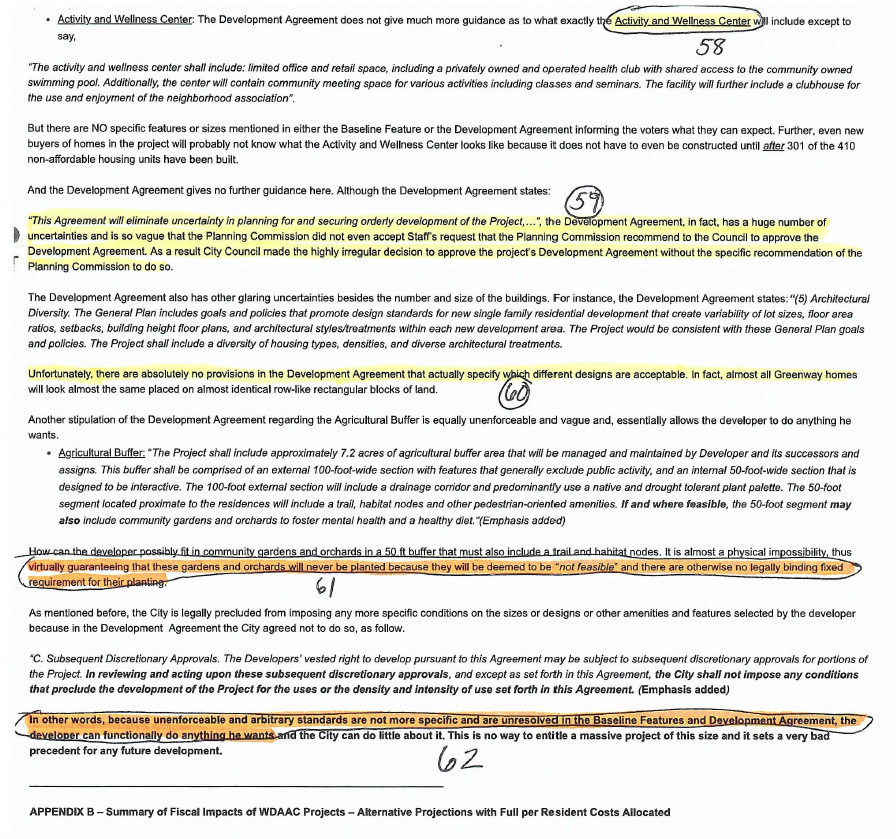
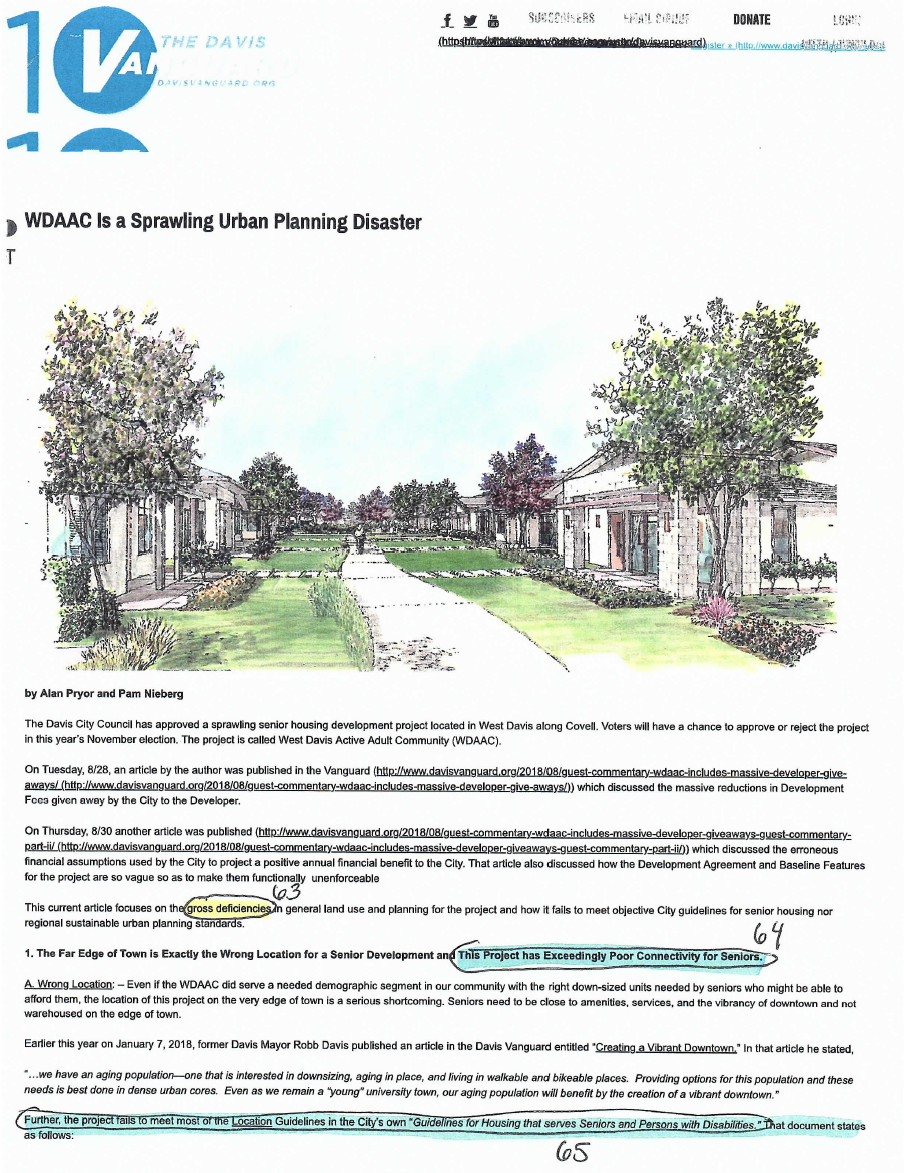
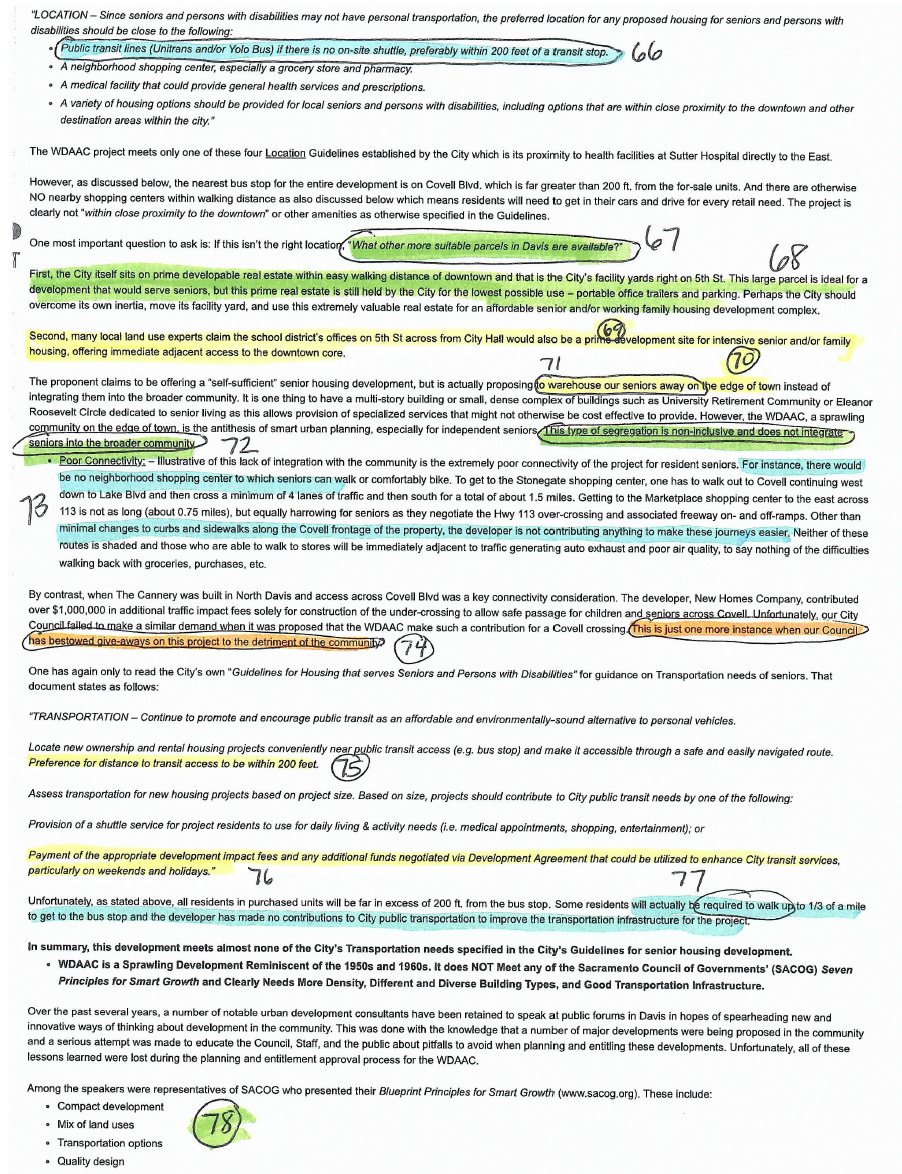
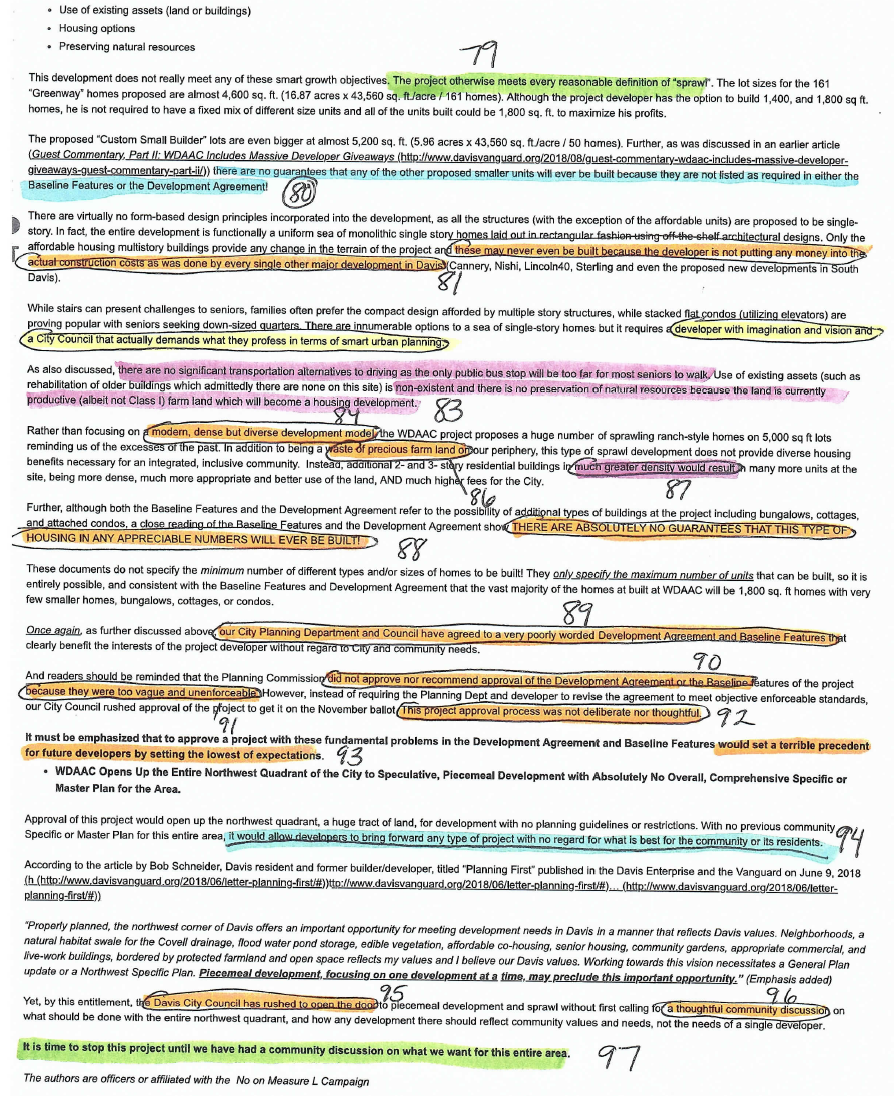




This is the third time in about a week and a half that Jason Taormino has turned down an opportunity to substantiate and back up his accusations and has refused to step up to the plate, even with significant hand-holding by the Davis Vanguard. It’s not difficult to see why the WDAAC project proponents have been avoiding debates.
A full 8 days after David Greenwald called out the Taormino for refusing to substantiate his claims [9/9/2018] “…the response from David Taormino yesterday was not particularly helpful either. Mr. Taormino claims, “Their first article contained 23 misleading, distorted and exaggerated statements.”… It would have been more helpful for Mr. Taormino to simply correct the record by sampling a list of what he viewed as inaccurate statements and then correcting them on an objective basis, ” we have now been presented a highlighted/numbered facsimile with no content. The Davis Vanguard even went out of their way to sit down with the development team to try to get something of substance and this is all that was produced.
It appears that, though the Taorminos are avoiding debates, they want to try to debate the project in the forum of the Davis Vanguard. To that end I would challenge them to actually respond to discussion on these so-called articles that they are posting and respond to substantive issues with substantive comments. For example, one of the No On WDAAC/Measure L representatives, Alan Pryor, posted a very detailed in-depth analysis of the claims of the affordable housing component of the project in this article yesterday: http://www.davisvanguard.org/2018/09/guest-commentary-erroneous-assumptions-hyperbole-used-justify-wdaacs-illegal-affordable-housing-program/ But there has been no response.
I posted comments/questions on the 9/13/2018 article by Taormino in which he said “Let there be no doubt, we welcome the opportunity to participate in a public forum on the merits of the West Davis Active Adult/ Measure L ballot item.” There was of course no response from him on this public forum he posted to. I would note that one thing has changed in the interim: 3 days ago on 9/14/2018 Taormino re-posted one of the two legal opinions that they had previously posted in January. He included a short preamble in which he confirmed for the second time in writing that their internal analysis concluded that their Davis-Based Buyers Program (AKA the sinisterly-named “Taking Care of Our Own” program) would not pass legal muster when applied just to current or former Davis residents or family of those residents because it provides preferences that favor a largely wealthy and white demographic: “I did not see any methodology to provide preferences based upon being a current Davis resident or being related to a current Davis resident because the demographics of Davis are not reflective of the regional averages. Our legal counsel agreed with this opinion…” Let’s emphasize this for a moment: even with the supposed policy justification based on Measure R that the project is trying to use, Taormino has admitted that the local preferences for City of Davis residents would be illegal and violate Fair Housing law. He then goes on to state that the proposed remedy for this is apparently to include a larger eligible group for the preferences: “We could provide preference to a group of people as long as that group was large, inclusive and non discriminatory. UC Davis and the Davis Joint Unified School district are non discriminatory organizations.” This is truly a bizarre claim: that because the project is including two organizations in the eligibility criteria that today have a broader, more inclusive demographic than current overall Davis demographics, that this somehow inoculates the project from claims of discrimination, even though the people eligible for the project based on age restrictions would have gotten their affiliation to these educational institutions in decades prior when the demographics were not nearly as inclusive.
The following are the previous statements and questions that I posted. I challenge Mr. Taormino to respond to these here in this public forum:
There is a FAQ document on the City website for the project authored by you [https://cityofdavis.org/home/showdocument?id=8285]. I have three questions about some of the statements and I am challenging you to respond to them:
Density
J. Taormino: “#7. Is this a low-density neighborhood? This is a combination of high density and medium density housing. The affordable apartments are high density, the University Retirement Community area will be medium density, the single family detached homes will be medium density and the attached/condos/stacked flat areas will be medium density.”
D. Greenwald 9/9/2018: “The first problem with this proposal is that it is basically a classic low-density, peripheral housing project….Without the Davis-Based Buyer’s Program, this is basically Cannery all over again. Market rate, single-family homes, some of which may serve the purpose as outlined by the developers – but we have no way of really knowing. ”
No On WDAAC [website]: “WDAAC is a sprawling, unsustainable Development, in the wrong location for a senior development, and opens up the entire northwest quadrant without any planning….It does not meet any of the Sacramento Council of Governments’ (SACOG) Seven Principles for Smart Growth and clearly needs more density, different and diverse building types, and good transportation infrastructure…The far edge of town is exactly the wrong location for a senior development and this project has exceedingly poor connectivity for seniors.”
Question #1: So, what are the “facts”? Low-density peripheral sprawl as The Davis Vanguard/No On WDAAC state, or a combo of high-density/medium-density as you state?
Legality
J. Taormino: “#10. Will you restrict the homes to only those that currently live in Davis?
Our goal is to provide housing for the larger Davis community. We know from many conversations that a lot of us have aging parents that we’d like to bring to Davis but there are limited options to do so, which is part of the current community need. However, we all recognize that the legality of discriminating based upon zip code is questionable. Nevertheless, we think that there is a large number of current Davis residents that will be interested in right sizing to a single level home with solar, universal design and energy efficiency, without doing an intensive out of community marketing effort. The need for this neighborhood is homegrown.”
D. Greenwald 9/9/2018: “But the other problem is there is no way to know that this is going to pass legal muster. As noted at the council meeting, these restrictions are not tied into the Project Baseline Features or even the Developer’s Agreement. So, the developers are in no way bound to adhere to it.”
No On WDAAC [website]: “These types of locational preferences for housing—especially in a community with a history of housing practices that have favored white people and excluded minorities—are highly problematic in terms of fair housing law.
Question #2: everyone agrees that the legality of the the project and the included Davis Based Buyer’s Program is highly questionable at minimum, so how has your description of the project legality changed? Which of your versions of the “facts” has the most “honesty” and integrity?
Process
J. Taormino: “14. Are you avoiding entering into a development agreement? No. We have heard from the Community that they wanted to participate in the development agreement deal points. Development agreements are mostly boilerplate language mitigating risks, defining payment options and a few specific deal points. We expect all the significant deal points that are normally in a development agreement to be in the Baseline Features & Requirements so that they are evident to the voters. The citizens then have a direct contract with the developer that is only changeable with a new vote.”
D. Greenwald 9/9/2018: “As noted at the council meeting, these restrictions are not tied into the Project Baseline Features or even the Developer’s Agreement. So, the developers are in no way bound to adhere to it.”
No On WDAAC [website]: “It is critically important to note that the number of each different type and size of units to be built is not guaranteed in the Baseline Features or in the Development Agreement. It is entirely possible that the number of smaller cottages, bungalows, and condos will be severely reduced or even eliminated, and, alarmingly, this would still be consistent with the Baseline Features and Development Agreement…In fact, the Council has already agreed with the developer that any changes they might make in the Development Agreement in the future will automatically be considered to be compliant with the Measure R Baseline Features because those Baseline Features are so poorly written….the City is legally precluded from imposing any more specific conditions on the sizes or designs or other amenities and features selected by the developer because in the Development Agreement the City agreed not to do so as follows:
“C. Subsequent Discretionary Approvals. The Developers’ vested right to develop pursuant to this Agreement may be subject to subsequent discretionary approvals for portions of the Project. In reviewing and acting upon these subsequent discretionary approvals, and except as set forth in this Agreement, the City shall not impose any conditions that preclude the development of the Project for the uses or the density and intensity of use set forth in this Agreement.
In other words, because unenforceable and arbitrary standards are not more specific and are unresolved in the Baseline Features and Development Agreement, the developer can functionally do anything he wants and the City can do little about it. This is no way to entitle a massive project of this size and it sets a very bad precedent for any future development.”
Question #3: you pledged that all “significant deal points” would be in the Baseline Features & Requirement. However, this is clearly not the case. All of your promotional material for the project includes the “Taking Care of Our Own” tagline for the Davis-Based Buyers Program, yet it isn’t even a part of the Baseline Features of the project. Nor are the affordable housing measures. Additionally, the Development Agreement itself is so weak and toothless that the vague guidelines set forth within can be easily maneuvered out of. The “direct contract with the voters” that you have pledged is nothing more than an empty promise. Is the the example of “integrity” and “honesty” that you are talking about?
Finally, in regards to the legality of the project, I add the following for Taormino to discuss in this public forum the 2002 Langlois v. Abington Housing Authority decision and related cases that look very skeptically at the exact type of circular reasoning used as policy justification for exclusionary residency preferences that the WDAAC project is using. As a reminder, Taormino has admitted that the proposed “Taking Care of Our Own” program would be illegal with a preference for Davis residents (current or former, and family of them). However, neither he nor his two attorneys cited this nor any other of a large number of other similar and relevant fair housing cases.
See this summary of Langlois: “Judge Gertner there concluded that the defendants could not simply cite the goal of wanting “to make it easier for their residents to keep living in their communities,” because this basically just reflects “the very definition of residency preferences. If I accepted these as legitimate justifications, residency preferences in and of themselves would forever justify the disparate impacts that they cause.” Rather, she held: “defendants must set forth the reasons why they want the preferences. And it is the reasons that must be legitimate. [Defendants] must offer a record of local conditions and needs that suggests why the residency preferences are necessary, [such as] a fire in the community has left an abnormally high number of residents homeless [or] economic factors have hit the community especially hard—a plant closing, for example.” [http://furmancenter.org/research/iri/essay/the-community-preference-policy-an-unnecessary-barrier-to-minorities-housin]
See also this admonishing statement of the judge in that case: “nowhere do the defendants demonstrate that they even considered the impact of their residency preferences on minorities and on their compliance with other civil rights obligations.”
Taormino uses an unconvincing argument that current diversity levels and nondiscriminatory practices at UC Davis absolves the project from “considering the potential impact of their residency preferences on minorities.” There is no attempt by the project proponents to examine the historic ethnic/racial makeup for student/staff at UC Davis when persons of current retirement age would have attended UC Davis or first started working there. There is also no attempt by project proponents to examine the racial/ethnic makeup of persons of retirement age currently residing in Davis.
Just as a reminder about the 1978 Regents of the University of California v. Bakke case that struck down race-based quotas, but upheld affirmative action programs: the UC Davis medical school had reserved 16 out of 100 seats in its entering class for minorities, including “Blacks,” “Chicanos,” “Asians,” and “American Indians.” So the University was trying to get to 16% minority representation using quotas, but that was stuck down. I don’t have the stats on hand, but the actual minority student makeup was presumably much less than that at the time.
A 21-year old in 1978 would be 61 years old today and in the targeted age group for the WDAAC project. But the project proponents are disingenuously only looking at current UC Davis diversity figures to try to absolve their project from considering disparate impacts on minorities in their targeted age group. There has been no effort by project proponents to provide any information about this topic or to address it.
“The Davis Vanguard even went out of their way to sit down with the development team to try to get something of substance and this is all that was produced.”
I am expecting a substantive response on a range of the key issues raised here.
David: in the last go-round on this more than a week ago, you admonished the development team to provide a substantive backup to their allegations. Then you ended up writing an article yourself to do some of that for them. Now you are holding meetings with the development team and hand-holding them to try to get an actual substantive discussion from them. This is ludicrous.
I think you and I have vastly different ideas about what your mission statement actually means in terms of what the role and practices of an independent investigative journalist should be: “a 501(c)3 non-profit, a community-based watchdog and news reporting organization that… seeks to bring transparency, accountability and fairness to local government, while promoting social justice and democracy, and adhering to principles of accuracy and fairness in our reporting.”
I can’t make them submit stuff. They told me they were sending a more substantive response – I don’t know when.
I’m in no way a fan of this proposal (and am reluctant to provide any positive suggestions for the developer), but attacking the opposition in this manner is not going to be a winning strategy.
However, unlike Nishi, I suspect that this proposal is probably already on track to lose – regardless of the arguments put forth at this point. (Due to the nature of the proposal, itself.)
May I simply state the obvious? Labeling assertions with colored markers does not provide evidence to the contrary or refute the statements made. So, I’m not sure what the point of this exercise is. It’s quite uninformative. What’s false about the falsehoods? How do the distortions distort the truth? If something is “half true,” in what sense is it true and in what sense false? The italicized portion of the following statement is labeled as an exaggeration: “This decision creates a very bad planning precedent for future developments” (No. 30.) Is this an admission that the decision does create a bad planning precedent, if not a very bad one?
It’s fine that the development team plans to elaborate on “some” of this. For now, however, this colorful display serves little purpose other than obfuscation.
Eric: I am picturing a property developer back in the year 1517 deciding to follow the example of Martin Luther, but instead of nailing 95 Theses to the doors of churches to demand reform and to put forth propositions to be debated in a public forum, he put together a response to objections to his proposal by opponents that consisted solely of a list of 97 numbers (2 more than ol’ Martin!) with each entry reading “TBD” or “watch this space”.
You can’t “prove a negative” how will the developer “prove” an agreement is “non binding” when it actually is binding?
If the developer is lying this document should make it easy for Eric and Alan to catch them in a lie (like posting a development agreement signed by the city and developer that specifically says this is a “non-binding agreement” and “the city will let them do whatever they want down the road”.
I’m not holding my breath that Eric or Alan will do anything but double down with more “misleading, distorted and exaggerated statements”…
Ken –
I’m not sure what your point is. Proving that an agreement is binding or non-binding is done all the time in contract law.
And please give an example of where anything I’ve said on this topic has been “misleading, distorted and exaggerated.” (Helpful hint: I’m not an author of the Guest Commentary addressed in this article.)
Ken A: there has been ample quoting of the exact development agreement language and it would be a trivial matter for you to look at the DA yourself.
But the larger issue is this: as David Greenwald has said previously (9/9/2018): “As noted at the council meeting, these restrictions are not tied into the Project Baseline Features or even the Developer’s Agreement. So, the developers are in no way bound to adhere to it.”
Even the project developers discuss how DAs are inherently weak. From the Project FAQs on the City of Davis project website written by J. Taormino [my emphasis]: “14. Are you avoiding entering into a development agreement? No. We have heard from the Community that they wanted to participate in the development agreement deal points. Development agreements are mostly boilerplate language mitigating risks, defining payment options and a few specific deal points. We expect all the significant deal points that are normally in a development agreement to be in the Baseline Features & Requirements so that they are evident to the voters. The citizens then have a direct contract with the developer that is only changeable with a new vote.”
So, why have the developers broken their promise and not included all of the significant project features in the Baseline Features for the project? Why do they not want to enter into a contract with city of Davis voters for these components of their project?
Baseline features here: https://cityofdavis.org/home/showdocument?id=9205
Draft Development Agreement here: https://cityofdavis.org/home/showdocument?id=9187
Just a suggestion for people writing on both sides of this issue: anything over 1000 words is really stretching the reader’s attention span. I suggest maybe some bullet points, summary lists of questions, and perhaps just link back to previous articles for supporting commentary. We’re getting 2000 – 4000 word posts and comments here. From everything I know about writing and editing those are simply too long to be effective.
http://www.slate.com/articles/technology/technology/2013/06/how_people_read_online_why_you_won_t_finish_this_article.html
Fair enough. However, while I produced a long response, my points are summarized (the site often does funky things to my formatting: I haven’t figured that out yet) with some of the key points in bold. A reader could easily just look at those and get more information from the surrounding text as desired. This response also has gotten long because the project proponents have refused to answer questions or engage in any type of discussion.
This is also an unintentionally ironic comment for an “article” that consists almost entirely of a copy of multiple pages of an existing dense document with markups that provide no added value.
I have a couple suggestion too: 1) articles should have actual content, not just be “TBD”; 2) articles should not consist almost entirely of a re-post of a previous article posted on the site.
🙂
“I have a couple suggestion too: 1) articles should have actual content, not just be “TBD”; 2) articles should not consist almost entirely of a re-post of a previous article posted on the site.”
The Vanguard has a general policy of publishing public submittals that otherwise meet our criteria.
I think it is worth noting:
1. Alan Pryor submitted a 4000 word response article – it was published
2. The development team submitted the Lawyer’s letter on the Davis Based-Buyer’s program – it was published
3. They asked that their response to Alan’s three articles be published and we did so.
I would rather err on the side of publication and let the readers and commenters decide, than pick and choose. In the end, if the submittals are ineffective, that is on them.
Thank you. Personally, I couldn’t make it through the long and complicated articles and responses, so have no clear idea what this is all about. The campaign strategy seems to be making people feel too stupid to understand, but elicit a feeling of distrust.
Most everything published on the Davis Vanguard is really stretching the reader’s (or lack there-ofs) attention span. And it’s not always because of length.